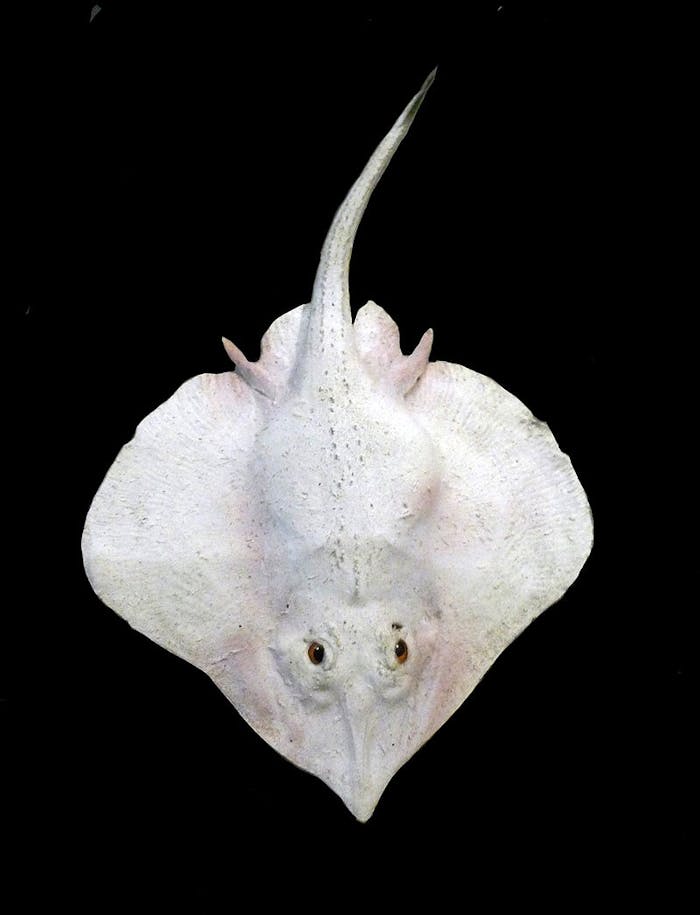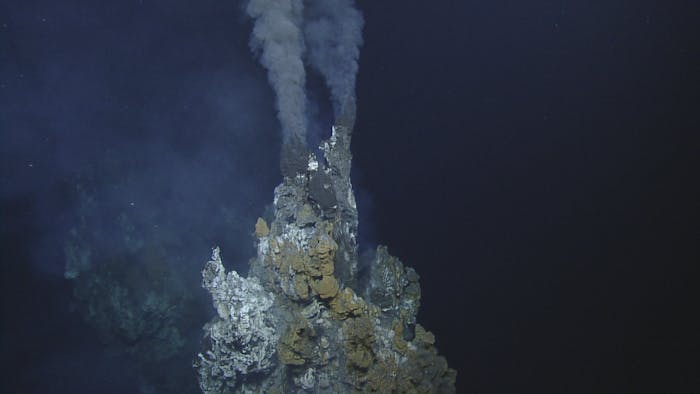The animals that laid them used hydrothermal vents as incubators.
Strange conditions in the murkiest depths of the ocean have led to the evolution of weird-looking animals that sometimes look like dicks but are, impressively, able to thrive in uniquely severe environments. One of the oddest and most inhospitable of these habitats is the area surrounding underwater volcanoes known as black smokers, which spew forth hot jets of chemicals from the Earth’s mantle that can reach temperatures of 650º-750º Fahrenheit. Scientists know that some hardy organisms rely on these chemical feasts to thrive, but they only recently realized that the searing heat from those vents might be crucial to their survival as well.
In a paper published Thursday in the journal Scientific Reports, an international team of scientists led by Pelayo Salinas-de-León, Ph.D. report an especially unusual discovery: that Pacific white skates (Bathyraja spinosissima), relatives of sharks that grow to have a wingspan of up to five feet, lay their eggs around hydrothermal vents in the Iguanas-Pinguinos vent field, about one mile below the sea just north of the Galápagos Islands.

While the fossil record has shown that dinosaurs laid eggs in volcanic soil, just like the still-living megapode, a ground-dwelling bird that lays its eggs in mounds of heat-generating, decomposing matter in Asia and Australia, this report marks the first time anyone has observed this behavior in a marine animal.

Pacific white skates are wide, flat fish that can live up to 10,000 feet below the surface of the ocean. What makes this species especially unique is that their eggs take a really long time to hatch: Researchers estimate that these eggs incubate for 1,500 days — more than four years. Laying the eggs around these deep-sea vents, the researchers hypothesize, could help shorten the time it takes for the eggs to hatch.

Since the hydrothermal vents of the Galápagos Marine Reserve are so deep underwater, the researchers had to use a remotely operated underwater vehicle (ROV) to explore what life could thrived there. Using the camera on the ROV, as well as a robotic arm that can gently manipulate objects, they observed the scene and collected four samples to confirm the species. In total, they found 157 egg cases, each about four inches long. Many of the cases were fresh, suggesting that the site was an active incubation area.

With the ROV’s camera, they also observed a bunch of older egg cases, indicating that skates had been laying their eggs around these vents for quite some time.
Even with the help of the hydrothermal vents, the water is still quite cold way down there — only a few degrees above freezing. So it makes sense that the skates are taking advantage of this environmental freebie.

Aside from being a startlingly strange find, documenting this phenomenon could assist conservation efforts in the future, as these deep-sea hydrothermal vents could soon be under threat. While it seems like something a mile under the ocean should be safe from human hinderance, they’ve recently become a target for mining companies hoping to extract methane or harvest the geothermal energy.
“We hardly know anything about the deep sea, and we are fishing, and mining, before we even get a chance to even document what species live down there and what unique behaviors [they] could reveal [to] us,” Salinas-de-León told National Geographic in an interview this month. Perhaps learning that these vents not only host the crabs and worms that we already knew about but also serve as nurseries for these strange and beautiful skates will teach us to be a little more hesitant to decimate these habitats for our own gain.
Abstract: The discovery of deep-sea hydrothermal vents in 1977 challenged our views of ecosystem functioning and yet, the research conducted at these extreme and logistically challenging environments still continues to reveal unique biological processes. Here, we report for the first time, a unique behavior where the deep-sea skate, Bathyraja spinosissima, appears to be actively using the elevated temperature of a hydrothermal vent environment to naturally “incubate” developing egg-cases. We hypothesize that this behavior is directly targeted to accelerate embryo development time given that deep-sea skates have some of the longest egg incubation times reported for the animal kingdom. Similar egg incubating behavior, where eggs are incubated in volcanically heated nesting grounds, have been recorded in Cretaceous sauropod dinosaurs and the rare avian megapode. To our knowledge, this is the first time incubating behavior using a volcanic source is recorded for the marine environment.

